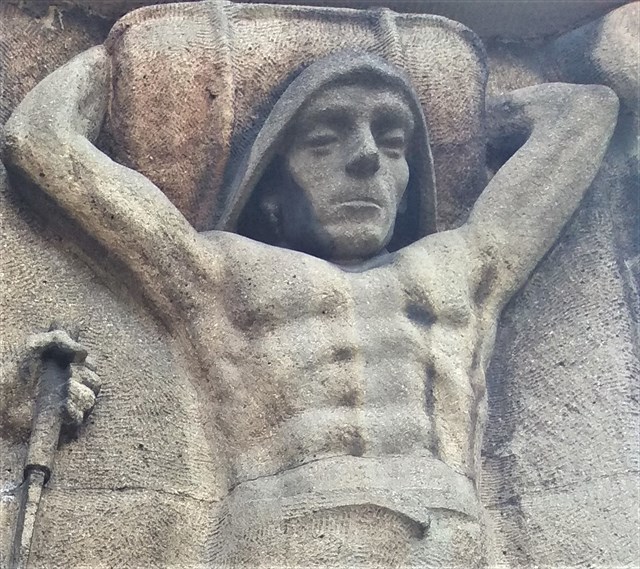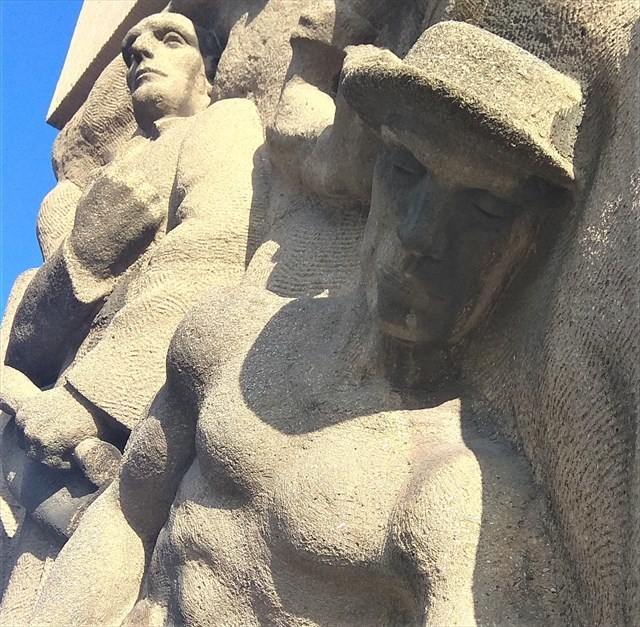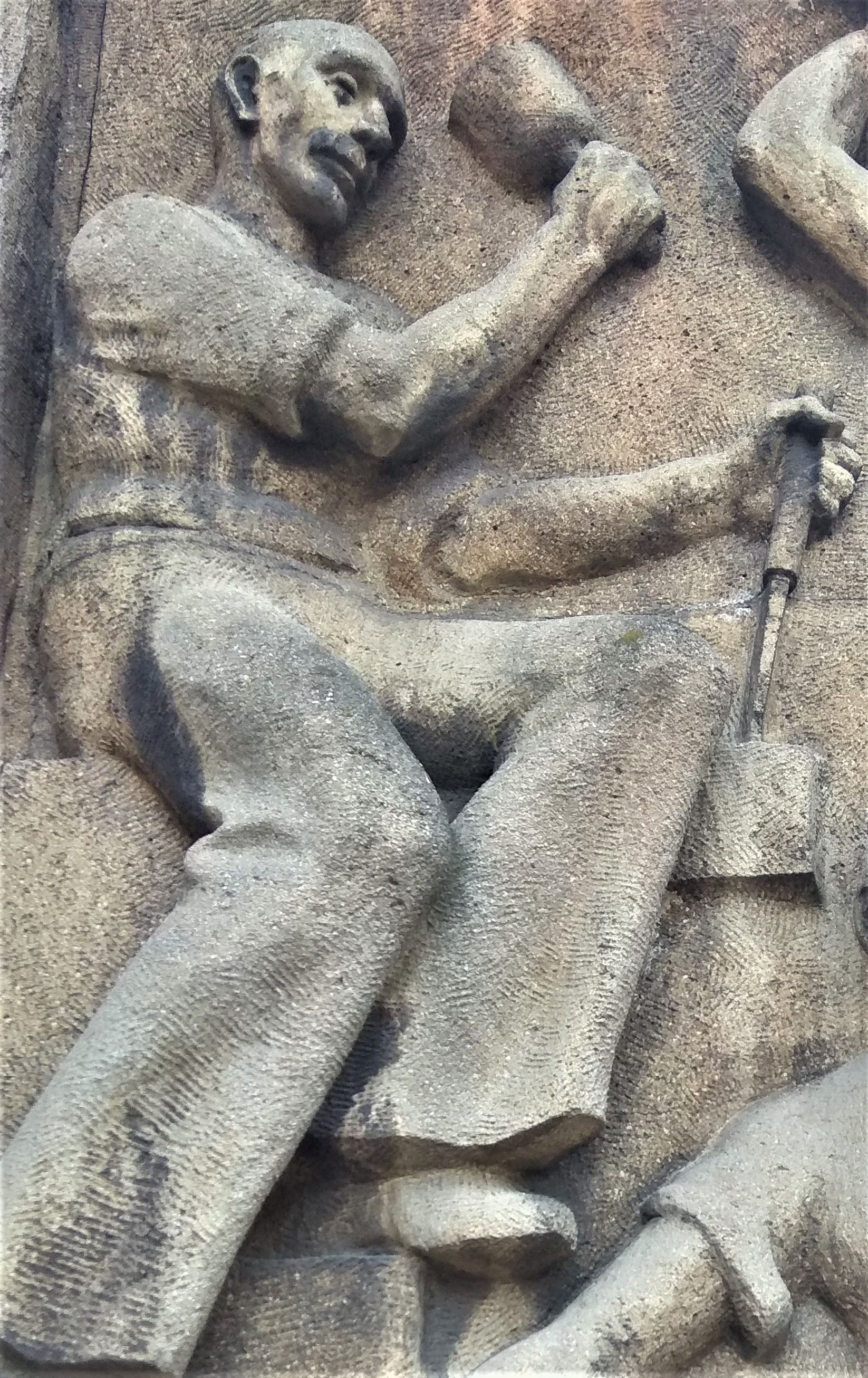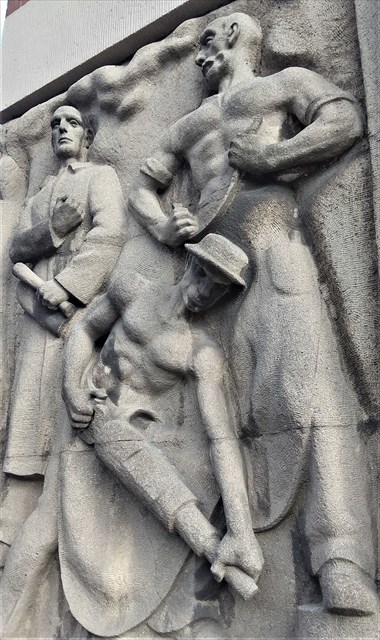Na prostopadłościennej kolumnie, przy wejściu do banku, znajdują się cztery ciekawe płaskorzeźby. Można na nich zobaczyć przedstawicieli wielu zawodów podczas ich codziennych zajęć.


Relief został wykonany w 1938 roku przez Kurta Schwerdtfegera, rzeźbiarza, pedagoga, artystę, który przyczynił się do rozwoju ruchu Bauhaus. Autor, urodzony w 1897 roku w Deutsch Puddiger (obecnie Podgórki koło Malechowa, powiat Sławno), brał udział jako żołnierz w pierwszej wojnie światowej. Po niej studiował filozofię i historię sztuki na Uniwersytach w Królewcu i w Jenie, a następnie, w latach 1920–1924, w Bauhaus w Weimarze. Tam, wraz z Ludwigiem Hirschfeldem-Mackiem, stworzył dzieło „Reflektorische Farbenlichtspiele”, które zmieniło pojęcie sztuki przestrzennej w XX wieku, a także jest przykładem abstrakcyjnej awangardy filmowej lat dwudziestych XX wieku oraz prekursorem kina rozszerzonego. Od 1925 roku Schwerdtfeger był nauczycielem rzeźby w szczecińskiej Werkschule für Gestaltende Arbeiten. Wtedy powstawały rzeźby budowlane na Pomorzu i w Gdańsku.
Pod koniec lat trzydziestych naziści uznali twórczość Kurta Schwerdtfegera za „sztukę zdegenerowaną”. W 1937 roku rzeźbiarz został odwołany ze stanowiska wykładowcy i zmuszony do opuszczenia Szczecina. Większość jego prac usunięto z muzeów bądź zniszczono. Szczęśliwym trafem czterech płaskorzeźb, zdobiących modernistyczny gmach Pommerscher Bank (Oddział Pomorskiego Banku SA w Szczecinie), wybudowany w Koszalinie w latach 1936 - 1938 przez architekta Gregora Rosenbauera, nie usunięto. Po II wojnie światowej przedwojenne reliefy można było traktować jako przykład socrealizmu i pewnie dlatego nie zostały zniszczone jak inne obiekty przypominające czasy przedwojenne.



Prace Schwerdtfegera wystawiano w latach trzydziestych między innymi w Metropolitan Museum of Art w Nowym Jorku i w Paryskim Centre Pompidou. Po wojnie w 1946roku został on profesorem sztuk pięknych na Uniwersytecie Edukacyjnym w Alfeld, gdzie pracował do śmierci.
Zadanie:
Na dole jednej z płaskorzeźb znajduje się podpis Kurta Schwerdtfegera, który należy uwiecznić na fotografii wraz ze swoim GPS-em, TB logowanym w tym keszu, kartką ze swoim nickiem lub swoją podobizną. Logi bez wykonania tego zadania będą kasowane.
 English description:
English description:
The Cache:
On the rectangular column, at the bank entrance, there are four interesting bas-reliefs. You can see representatives of many professions during their daily activities.
The relief was made in 1938 by Kurt Schwerdtfeger, a sculptor, teacher and artist who contributed to the development of the Bauhaus movement. The author, born in 1897 in Deutsch Puddiger (now Podgórki near Malechów, Sławno poviat), took part as a soldier in the First World War. After that, he studied philosophy and history of art at the Universities of Königsberg and Jena, and then, in the years 1920–1924, at Bauhaus in Weimar. There, together with Ludwig Hirschfeld-Mack, he created the work "Spotlight" by Farbenlichtspiele, which changed the concept of spatial art in the 20th century, and is also an example of the abstract film avant-garde of the 1920s and the precursor of expanded cinema. From 1925, Schwerdtfeger was a sculpture teacher at the Werkschule für Gestaltende Arbeiten in Szczecin. At that time, building sculptures were created in Pomerania and Gdańsk. In the late 1930s, the Nazis recognized Kurt Schwerdtfeger's work as "degenerate art." In 1937, the sculptor was dismissed from his lecturer's office and forced to leave Szczecin. Most of his works were removed from museums or destroyed. Luckily, four bas-reliefs adorning the modernist building of Pommerscher Bank (Branch of Pomorski Bank SA in Szczecin), built in Koszalin in 1936 - 1938 by architect Gregor Rosenbauer, were not removed. After World War II, pre-war reliefs could be treated as an example of socialist realism, and probably that's why they were not destroyed like other objects reminiscent of pre-war times. Schwerdtfeger's works were exhibited in the 1930s at the Metropolitan Museum of Art in New York and at the Center Pompidou in Paris. After the war in 1946, he became a professor of fine arts at the University of Education in Alfeld, where he worked until his death.
Task:
At the bottom of one of the reliefs is the signature of Kurt Schwerdtfeger, which should be visible on the photo together with your GPS, TB logged in this cache, sth with your nick or your picture. Logs without this task will be deleted.
Virtual Rewards 2.0 - 2019/2020
This Virtual Cache is part of a limited release of Virtuals created between June 4, 2019 and June 4, 2020. Only 4,000 cache owners were given the opportunity to hide a Virtual Cache. Learn more about Virtual Rewards 2.0 on the Geocaching Blog.